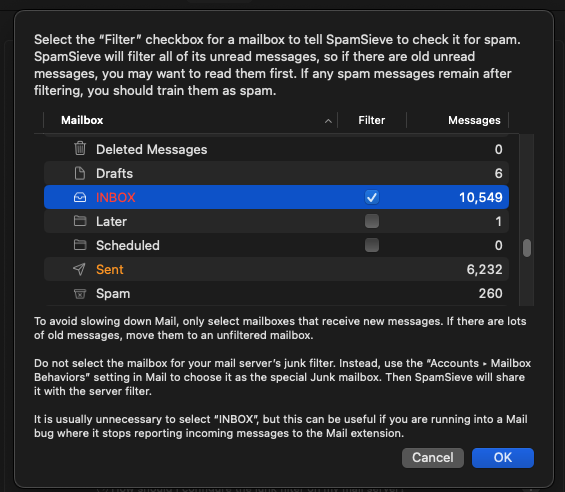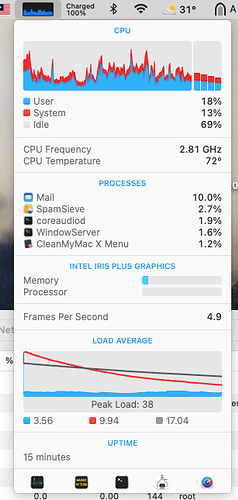Ever since I upgraded to SpamSieve 3.0, SpamSieve is almost always the process using the most CPU time, usually somewhere from 85%-110% of % CPU. At first I thought it might just be an initial indexing that was taxing the CPU, but it’s been days and it’s still going on. My mail database is definitely large but it seems odd that 4 days after the upgrade this is still going on. Any ideas on how to resolve?
Please send in a sample report so that we can see what it’s doing with the CPU.
A post was split to a new topic: High CPU use with Microsoft Outlook
I never received the sample report, but there is some general information here about how to diagnose and fix slowness with Apple Mail.
I have a similar issue. My iStats Menu as well as Activity monitor report SpamSieve and Mail to be main resource consumers.
I’ll now email my log files to spamsieve (AT) c-command.com to have this further investigated. Hopefully, the operations of SpamSieve&Mail can be further optimized with the help of my submission.
Thanks, Michael!
Thanks for the samples. It looks like SpamSieve’s Filter spam messages in other mailboxes feature was reading the inboxes in Mail to determine whether there were any new messages that needed filtering. I’m working on making this more efficient—and maybe Apple will fix the bug so that none of this scanning is necessary—but in the meantime the two things you could do are:
- Archive older messages out of the mailboxes that are selected for filtering so that there are fewer messages to go through to find the new ones.
- Set SpamSieve to check less frequently.
Thank you for the quick response.
Good to know you seem to know what causes the problem and are continuously working on improving SpamSieve.
I had activated the “Filter spam messages in other mailboxes” feature (whereby I only ticked my three email accounts’ INBOXes) in order to make SpamSieve work with the Sonoma Apple Mail setup at all. Before that, mails wouldn’t be filtered (handed to SpamSieve?) at all.
I had read about this workaround here in the community forum IIRC.
Should this “workaround” not be necessary anymore at this moment? Can I deactivate it? (I don’t really need any spam filtering in other mailboxes than the Inbox(es) )
(As advised, I have changed the “Filter spam messages in other mailboxes” 60sec interval to 90sec. Perhaps that would help, too. )
On another note, one of my three Inboxes is marked red in the Mailbox selection view. Is that because it contains “many” messages? The threshold for “many” being perhaps 10,000 ?

Yes, you still need the workaround to filter the inboxes. Currently, the threshold for red is 10,000 messages, but this is subject to change and not a definitive indicator of what is “too many” for your particular Mac.
SpamSieve 3.0.1b2 can now automatically filter new messages in the inbox that Mail failed to send to the Mail extension. If you reduce the inbox size so that it’s not orange or red, you can deactivate the workaround above.
Great update! Good job! Downloading & installing it now.
Hard for me to reduce the inbox size to < 5000 messages.
If (only) new messages get set to SpamSieve for filtering, wouldn’t the mailbox size be irrelevant?
Can you please elaborate why do you mention the “if not orange/red, (only?) then can deactivate the workaround”.
Thank you ![]()
I’m working on a solution for large inboxes (without having to move the messages elsewhere), but the immediate priority was to get things working fully automatically for folks with smaller inboxes.
It needs to look at the whole inbox to determine which messages are new.
This is referring to the colors in the Select Mailboxes to Filter… sheet. If the mailbox is not orange or red, it’s small enough to be handled automatically by Check inboxes for new messages not sent to Mail extension so you don’t need to manually add it to Select Mailboxes to Filter….
If you update to SpamSieve 3.0.2b1, it will be much faster and use very little CPU.

